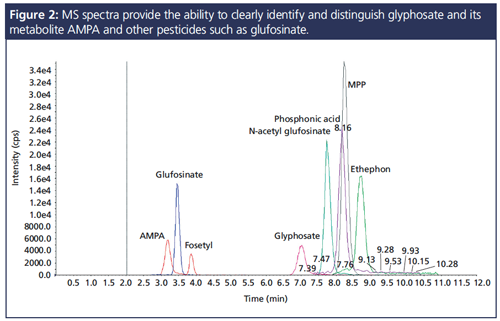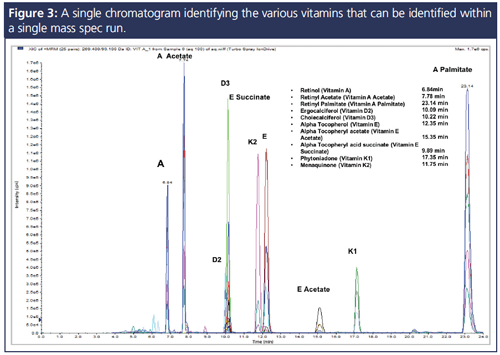Novel Methods Using Mass Spectrometry for Food Safety—From Contamination to Nutrition
The Column
This article highlights three events that require new method development to meet various detection needs, ranging from the detection of pesticides such as fipronil and glyphosate, to the detection and quantification of fat-soluble vitamins.
Photo Credit: Trong Nguyen/Shutterstock.com

Ashley Sage, Jianru Stahl-Zeng, and Philip Taylor, Sciex, Framingham, USA
Modern eating habits have led to the further diversification of an already complex food supply chain. The public confidence in the food supply is not only impacted by publicized crises involving contaminations, but also through the misreporting of nutritional information. Food analysis is integral to the whole supply chain, be it through a rapid response to a food crisis, such as the fipronil egg scandal, the continued monitoring of pesticides that could harm an unsuspecting public, or accurately reporting nutritional information to provide the information the public need to make an informed decision about the food they eat. Each event is fraught with difficulties, but by developing new methods of analysis, crises in the food industry can be avoided or their effects mitigated. This article highlights three events that require new method development to meet various detection needs, ranging from the detection of pesticides such as fipronil and glyphosate, to the detection and quantification of fat-soluble vitamins.
Modern diets have resulted in unprecedented growth and diversification of the food supply chain. The necessity of a continual supply of food means crops are commonly being treated with pesticides that are essential to reduce the risk of failed harvests. These chemicals are toxic to both insects and humans, and as such the public must be protected from unsafe concentrations of pesticides. Regulations imposed by food standard agencies dictate pesticide maximum residue limits (MRLs), which ensure the food on supermarket shelves is safe for consumption. In addition to ensuring food is free from contaminants, it is also essential to provide the public with accurate nutritional information to help enable the healthy growth of the global population.
To meet these goals, emphasis is placed on food content analysis to ensure quality and consistency between batches. Characterization and detection techniques, such as mass spectrometry (MS), offer manufacturers and producers the ability to screen large quantities of samples in a timely fashion, while guaranteeing reliable, repeatable measurements. Approaches to analysis are generally twofold: proactive monitoring of essential nutrients and possible contaminants; and crisis response, where widespread contamination requires the rapid development and deployment of analytical methods and equipment.
Rapid Response: Fipronil Egg Contamination
One recent example highlighting the need for a crisis response is the fipronil contamination of eggs, which resulted in the recall of millions of eggs. Fipronil is an insecticide, belonging to the phenylpyrazole family of chemicals, developed in the 1980s (1). Its high toxicity makes fipronil useful for controlling levels of insects including fleas, mites, and cockroaches, and is even useful against pests resistant to various insecticides (2). However, in July 2017 fipronil made news headlines after it was found to be present in eggs across Europe. This crisis was so widespread that by the end of August, fipronil-contaminated eggs were detected in 15 European countries and as far afield as Hong Kong and China.
Fipronil treatment for crops used in the food chain is prohibited and the US Environmental Protection Agency (EPA) has labelled fipronil as possibly carcinogenic, prohibiting its presence in the food chain (3). Furthermore, the European Food Safety Authority (EFSA) dictates fipronil concentrations of under 5 µg/kg to be safe for human consumption (4). Complying with concentrations dictated by regulation is therefore vital for manufacturers and producers to ensure the continued safety and confidence in food supplied to the public. Detection methods form one essential part of this process, identifying and quantifying potential contaminations prior to distribution in the food chain. There are several plausible methods of detecting contaminants such as fipronil in samples of food. The most common detection methods include liquid chromatography–tandem mass spectrometry (LC–MS/MS) and gas chromatography–mass spectrometry (GC–MS), with both requiring different methods of sample preparation prior to analysis.
The challenge arises in detecting fipronil concentrations at the low level stipulated by government regulation, but novel methods capable of detecting fipronil and its associated metabolite, fipronil sulfone, have been developed. Since the fipronil contamination scandal began, demand for a fast, sensitive detection method has only continued to grow. One such detection method involves a modified QuEChERS sample preparation technique prior to detection using a triple quadrupole instrument and electrospray ionization (ESI). The high sensitivity of detection and ability to analyze two compounds in the same run enable regulationâcompliant detection in a timely manner. This developed method can detect fipronil, as well as its major metabolite fipronil sulfone, to the MRL level of 5 µg/kg, as demonstrated in Figure 1 (5).

In responding to food contamination crises, it is also prudent to develop methods that can screen for multiple contaminants at once, potentially preventing contamination from other, unexpected sources. Using nontargeted approaches, such as SWATH acquisition, contaminant detection is not limited to the chosen molecule, in this case enabling the analysis of fipronil and other contaminants such as pesticides and polyaromatic hydrocarbons (6). Combining instrumentation that provides linear, reproducible contaminant detection to regulation-specific concentrations, with novel sample preparation methods, is essential to avoid repeated events, and helps improve public confidence in the integrity of the food supply chain.
Continual Monitoring: Glyphosate Pesticide
While fipronil is known to be hazardous for health, regulatory advice on other pesticides such as glyphosate is conflicted. Glyphosate is a widely used broadâspectrum systemic herbicide and crop desiccant. While it has recently made headlines for its potentially hazardous nature to humans as a possible carcinogen, its impact on human health is contested and therefore, the use of glyphosate as a farming pesticide is still permitted (7). In cases where potentially harmful pesticides are being used, continual monitoring is required to ensure chemical concentrations in foods are safe. Glyphosate is used globally and has been detected at trace levels, along with related metabolites, in 45% of European topsoils (8), and in samples of milk (9).
The controversy surrounding the use and potential contamination of glyphosate has placed greater emphasis on data collection and analysis methods to ensure levels of glyphosate in food samples fall below the safe MRL (reported by the EFSA as 50 µg/kg) (10). However, while the analysis of glyphosate and its associated metabolites is essential, its detection presents different sample preparation and analysis challenges that must be overcome. The high polarity of glyphosate and its related metabolites previously made sample extraction and LC analysis difficult. To overcome retention issues, derivatization using a method using fluorenylmethyloxycarbonyl chloride (FMOC-Cl) as the derivitization reagent to convert glyphosate into an analogue that can then be analyzed. However, while this approach enables detection, it is both complicated and time-consuming and fails to detect pure glyphosate and its metabolites.
Currently, the detection of underivatized glyphosate can be achieved using new methods of extraction coupled with instrumentation. One such underivatized method of detection starts by using the QuPPe (Quick Pesticide Preparation) extraction method to prepare samples (11). Using a combination of this approach with sensitive MS instruments, accurate quantification of glyphosate and its metabolites can be achieved. By combining the LC–MS/MS method with differential mobility separation (DMS) technology, interferences can be removed from analyses to improve the signalâtoânoise ratio and, consequently, increase confidence in quantification results. These samples are then analyzed using LC–DMS–MS/MS to quantify and identify those contaminants present, as shown in Figure 2.

Vitamin Detection in Food
General food composition monitoring is not limited to the detection of harmful contaminants. It also forms an essential component of the accurate reporting of nutritional information for packaging labels. Vitamins are vital nutrients that are essential for an individual’s growth and development. Deficiency in any vitamin is detrimental to health and is linked to a multitude of health issues. For instance, deficiency in vitamin D leads to the bone disorder known as rickets, and has been associated with other health problems including heart disease and cancer (12). While most vitamins can be obtained through natural means-exposure to sunlight is the best source of vitamin D-this is not always possible for some. Vitamin supplements are one option and are commonly incorporated into food, for example, infant formula. It is therefore imperative to report accurate nutritional information on food packages to ensure an individual’s vitamin needs are met and for manufacturers to correctly advertise the benefits of their products.
Vitamins broadly separate into two categories: water-soluble (vitamins B and C) and fat-soluble (vitamins A, D, E, and K). Detection of water-soluble vitamins is relatively easy, with analysis possible using MS. Conversely, analysis of fatâsoluble vitamins is difficult, owing to the challenges associated with MS detection. These problems originate from the presence of lipids in fat-soluble vitamin samples that cause an effect known as ion suppression (13), negatively affecting the detection, precision, and capability of a mass spectrometer. The ease in the detection of water-soluble vitamin samples is a direct result of the absence of lipids, enabling clean detection of vitamin B and C in samples (14). No uniform solution to ion-suppression exists, but its effects can be circumvented by the removal of lipids.
The detection of vitamins provides a specific detection challenge and, until recently, it was difficult to detect fat-soluble vitamins using LC–MS methods. Food samples contain various concentrations of vitamins, ranging from parts per billion to parts per million. To obtain clean, analyzable detection of fat-soluble vitamins, the lipid content should be removed from food samples. This reduces the ion suppression and enables robust MS analysis within a single chromatogram that identifies multiple vitamins, see Figure 3. Combining sensitive MS methods with associated expertise methodology allows universal application of the sample preparation and a simple analysis of vitamin concentrations in various food samples, meeting the specific requirements of the customer.

In Summary
Identification and quantification of potential contaminants and nutrients are essential to maintaining the integrity of the food supply chain. By avoiding unnecessary contamination of pesticides and providing clear labelling information, food manufacturers can be confident that food is safe for public consumption whilst also delivering accurate nutritional information. Continual methodological and instrumentation development will enable more sensitive and timely detection to continue for years to come.
References
- C. Tingle et al., Rev. Environ. Contam. Toxicol.176, 1 (2003).
- H. Kidd and D.R. James, Eds., The Agrochemicals Handbook (Royal Society of Chemistry, Information Services, Cambridge, UK, 3rd ed.,1991).
- U.S. Environmental Protection Agency, New Pesticide Fact Sheet - Fipronil; EPA 737-F-96-005 (U.S. Environmental Protection Agency, Office of Prevention, Pesticides and Toxic Substances, Office of Pesticide Programs, U.S. Government Printing Office Washington, DC, USA, 1996), pp 1–10.
- European Commission Pesticide Database, ec.europa.eu/food/plant/pesticides/eu-pesticides-database/public/?event=pesticide.residue.selection&language=EN, Accessed 30 April.
- Analysis of fipronil and amitraz insecticides, sciex.com/Documents/tech%20notes/Rapid-LC-MS-MS-Method-for-the-Analysis-of-Fipronil-and-Amitraz-Insecticides.pdf, accessed 30 April.
- Screening residual pesticides in fruit and vegetables, https://sciex.com/Documents/tech%20notes/X500R-QTOF-System-with-SWATH-Acquisition-for-Pesticide-Residue-Screening-in-Fruits-and-Vegetables.pdf, accessed 30 April.
- EFSA: Conclusion on the peer review of pesticide risk assessment of the active substance glyphosate,https://efsa.onlinelibrary.wiley.com/doi/pdf/10.2903/j.efsa.2015.4302, Accessed 30 April.
- V. Silva et al., Science of Total Environment 621, 1352 (2018).
- N. Chamkasem et al., Journal of Regulatory Science2, 20 (2015).
- European Food Safety Authority, EFSA Journal11(11), 3456 (2013).
- LC-MS/MS Analysis of Emerging Food Contaminants, https://sciex.com/Documents/tech%20notes/food_contaminants6500_QuPPe.pdf, accessed 30 April.
- D. Feldman et al., Nature Cancer Reviews14, 342 (2014).
- D. Volmer and L. Lee Jessome, LCGC North America24(5), 498–510 (2006).
- Analysis of Vitamin B complex in infant formula samples, https://sciex.com/Documents/brochures/vitB_infant_formula_QTRAP6500_09340214.pdf, accessed 30
- April.
Ashley Sage is the Senior Manager, Applied Markets Development at Sciex, Warrington, UK.
Jianru Stahl-Zeng is the Applications Manager and Global Technical Leader, Food & Environmental at Sciex, Darmstadt, Germany.
Phil Taylor is the Global Marketing Manager, Food, Environment & Forensics at Sciex, Warrington, UK.
E-mail:ashley.sage@sciex.comWebsite:www.sciex.com

Analytical Challenges in Measuring Migration from Food Contact Materials
November 2nd 2015Food contact materials contain low molecular weight additives and processing aids which can migrate into foods leading to trace levels of contamination. Food safety is ensured through regulations, comprising compositional controls and migration limits, which present a significant analytical challenge to the food industry to ensure compliance and demonstrate due diligence. Of the various analytical approaches, LC-MS/MS has proved to be an essential tool in monitoring migration of target compounds into foods, and more sophisticated approaches such as LC-high resolution MS (Orbitrap) are being increasingly used for untargeted analysis to monitor non-intentionally added substances. This podcast will provide an overview to this area, illustrated with various applications showing current approaches being employed.











